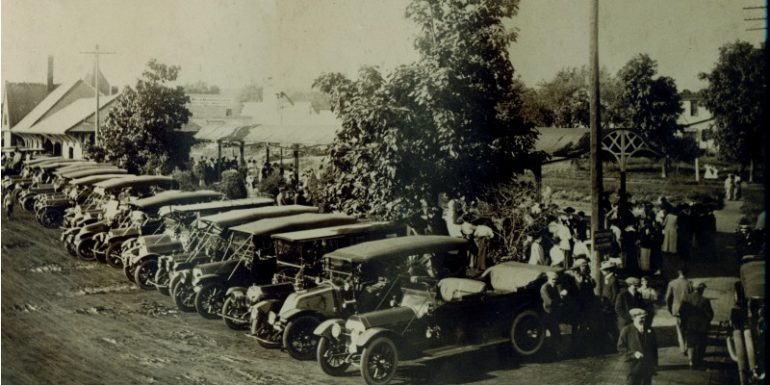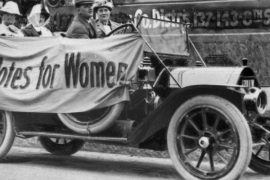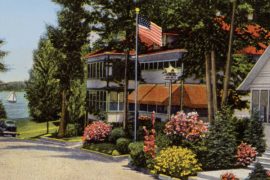By Anne Morrissy
On June 11, 1856, a large crowd of townspeople gathered at the first Lake Geneva train depot (historians think it was located on the south side of town most likely near the intersection of Curtis St. and town line Road) for one of the most exciting events that had ever happened in the small village. a 13-gun salute and a marching band welcomed the arrival of a Wisconsin Central train from Chicago via Elgin, six coaches carrying a total of 600 passengers. it was the first train to ever arrive in Lake Geneva. the passengers disembarked and followed the crowd to St. Francis de Sales church where a lavish picnic was served and railroad officials made speeches about the future.
Unfortunately, this first attempt at establishing train service from Chicago to Lake Geneva was short-lived. An economic crash in 1857 and the political climate leading up to the Civil War halted service and prevented opportunities for new investment. It would be more than a decade before a train returned to Lake Geneva. But whether or not the spectators on that historic day in 1856 imagined it,
The arrival of regular train service from Chicago would eventually transform Lake Geneva from a quaint, rural hamlet to an internationally known resort community, establishing this area’s identity in ways that still resonate today.
THE CHICAGO & NORTHWESTERN RAILROAD
By 1871, a small handful of moneyed Chicagoans had discovered the charms of country life around Geneva Lake, including Shelton Sturges, heir to a sizable grain elevator fortune, whose famous Lake Geneva estate Maple Lawn was built between 1870 and 1871. In a book called Steam Trains to Lake Geneva, railroad historian Paul L. Behrens suggests that Sturges may have used his influence in Chicago to encourage the Chicago & Northwestern Railroad to extend a line to Lake Geneva. Capitalizing on the groundwork of the abandoned tracks of the 1850s, the company was able to act quickly and install new steel tracks on the old rail bed. On July 20, 1871, the first engine on the new tracks arrived in Lake Geneva, “…and all the town heard its long and loud whistling,” according to newspaper reports of the era.
By July 26, 1871, regular train service between Chicago and Lake Geneva was finally established again, and this time it would change the dynamics of the area forever. The earliest timetables show one passenger train per day each way, with the trip into the city taking four hours and the trip to Lake Geneva taking nearly five hours total.
Almost immediately, tourists began arriving from Chicago at the new depot near the intersection of Broad and North streets (across from the current Dunn Lumber building). Former Lake Geneva city council member and train enthusiast Ed Yaeger explains, “When the railroad arrived here in 1871, the town went crazy.” The village, which had a total population of around 2,000 at the time, added a third hotel to its roster of businesses. Local residents also rented out rooms in their homes to capitalize on the new tourism industry. Lake Geneva, being the end of the line at the time, provided a distant sanctuary from the noise and pollution of the city, and the town residents were eager to capitalize on this.
The timing of the Chicago & Northwestern’s expansion to Lake Geneva was eerily prescient. Just three months after the line was extended, Chicago suffered the worst catastrophe in its history. The Great Chicago Fire burned for three days, from Oct. 8 to Oct. 10, 1871, during which time it destroyed 2,000 acres of property and left almost one-third of the city’s population homeless. In the immediate aftermath of the Great Fire, many Chicagoans who could afford to leave the city took the new train to Lake Geneva to escape the smoldering ruins and assess their rebuilding options. Once here, they decided that this area would make an ideal spot for a summer retreat, and many followed Sturges’ lead in building luxurious summer “cottages” along the shores of the lake.
ICE CUTTING
While the arrival of passenger trains shaped the future of downtown Lake Geneva, the arrival of freight trains had a significant impact on the area as well. Prior to the arrival of freight on the Chicago & Northwestern Line, the only way to ship or receive goods to Lake Geneva was via the Kenosha-Beloit Stagecoach Road (modern-day Highway 50) or a livery connection with the nearest train line in Springfield.
The arrival of freight trains in 1871 opened Lake Geneva up to much larger markets and inspired the growth of a new industry – ice cutting.
Before the invention of modern refrigeration, most families owned a piece of furniture called an “icebox.” Iceboxes contained a compartment for a block of ice which would keep the foods inside cool and fresh. The blocks of ice were harvested in the dead of winter from lakes, streams, and rivers in the north and stored for use year-round in triple-insulated ice houses. The ice was then shipped around the country via insulated train cars.
Geneva Lake was known for producing exceptionally clear, high-quality ice; it was advertised as “Ice from the sparkling clear water of Lake Geneva.” By the winter of 1873-1874, the ability to ship ice via freight train to Chicago led to an extremely busy ice harvesting season in Lake Geneva and provided a boon to the local economy.
The railroad would remain essential to local commerce for decades to come. Remembering his childhood in the first part of the 20th century, local resident Walter Schinke emphasized the importance of the train to the area: “At that time, the railroad was the main and most convenient route of travel for people, animals and all types of freight.”
THE WILLIAMS BAY EXTENSION
By the 1880s, the area’s burgeoning popularity with the wealthier classes of Chicago inspired another extension of the line, this time to Williams Bay. According to Behrens, the Chicago & Northwestern Railroad hoped to connect its train service with steam yacht service at the lakefront in order to provide access to all areas around the lake, not just the village of Lake Geneva itself. The railroad approached the Lake Geneva village council with a proposal to extend the tracks from the depot downtown along the lakefront to a new depot in what is now Library Park, but the village leaders turned them down.
So instead the railroad approached the village of Williams Bay, where they were able to purchase a large tract of land along the lakeshore from a son of the village’s founder, Israel Williams, for just five dollars. They constructed a depot at the lakefront and eventually built two large piers for the use of railroad-owned lake vessels, thereby allowing the Chicago & Northwestern to offer service to all points on the lake. The Williams Bay extension opened on June 1, 1888, and most of its early passengers were wealthy Chicagoans who owned homes on the lake and were met at the pier by their own steam yachts (commercial steamers did not start service until several years later.)
At the time, only one train a day continued on from Lake Geneva to Williams Bay, and this was known as “Redfearn’s Millionaire Mover,” Redfearn being the conductor of the train which famously carried Chicago’s wealthiest citizens. The parlor car of the train featured gilt letters announcing its terminus.
As part of the extension of the line to Williams Bay, the railroad also added a stop at “Duck Lake,” which was soon renamed Lake Como. The Lake Como platform was little more than a raised boxcar fitted with a small platform; it was located near present-day Mars Resort. Longtime residents recall that the platform was so small that all passengers traveling to Lake Como were required to sit in a designated train car. If a passenger failed to get on the proper car, they would fall into a ditch as they disembarked in Lake Como.
OTHER TRAIN LINES IN THE AREA
Although the Chicago & Northwestern Railroad arguably exerted the greatest impact on the Lake Geneva area’s ascension as a resort destination, it was not the only train line to affect Walworth County’s growth. Starting in the 1850s, the Chicago & Milwaukee Railroad (commonly known as the Milwaukee Road) came to Walworth County. That railroad’s Racine & Southwestern branch stopped in Lyons, Springfield, Elkhorn, Delavan and Darien, and its Eagle Branch broke off at Elkhorn and passed through LaFayette and Troy, as well as smaller junctions at Peck Station, Mayhew and Troy Center.
In 1899, an electric railway from Harvard, Ill., arrived in Fontana, providing the first train service to the west end of Geneva Lake. The next year, the Milwaukee Road began offering commuter service from Chicago to Walworth, with stops in Zenda and Fontana. In East Troy, an electric interurban railway connected the eastern part of the county to Milwaukee and its suburbs.
DECLINE OF THE TRAINS
From the 1890s through World War II, train ridership in America remained high. But by the 1950s, the introduction of the interstate highway system and the rise in automobile ownership took its toll on the passenger rail business. After 75 years of successful service from Chicago to Williams Bay, the Chicago & Northwestern made the decision to cut the Williams Bay extension. On New Year’s Eve, 1965, the final passenger train pulled into the station at Williams Bay. According to a newspaper report, “Four passengers got off, and a small group of local citizens watched.” And with that came the end of an era.
Passenger rail service to Lake Geneva was discontinued in August of 1975 and the last passenger train pulled into Walworth in 1982. The Lake Geneva depot came down soon thereafter and the tracks and bridges were slowly disassembled. Very little evidence exists today of the Chicago & Northwestern Railroad in Lake Geneva. And yet its influence on the area is undeniable. Today, the Lake Geneva area is a world-class resort community with a Four-Diamond resort hotel, celebrity-designed golf courses and opulent private residences, none of which would be here without the influence of the early Chicagoans who first came to this area and shaped its potential. They came to this lake and helped create a summer resort that is still thriving today. And when they came, they came by train.
Where to Find Walworth County’s Train History
- GENEVA LAKE MUSEUM (255 Mill St., Lake Geneva) – This museum of area history features a train exhibit and hosts a popular model train show every year.
- LAKE GENEVA’S HISTORIC SIGNAGE (throughout town) – Brown informational signs at former railroad sites around Lake Geneva tell the history of the trains.
- EAST TROY ELECTRIC RAILROAD MUSEUM (2002 Church St., East Troy) – This museum preserves an era in history when electric trolleys connected Walworth County to Milwaukee and its suburbs. Take a ride to The Elegant Farmer in Mukwonago on a restored trolley car.
- WHITE RIVER TRAIL (Western trail head at Highway H and Pinecrest Lane in Elkhorn)– A portion of the former Milwaukee Road tracks north of Lake Geneva has been restored for use as a bike trail. It runs between Elkhorn and Burlington, passing through Springfield and Lyons.
- PEDAL & CUP (1722 State Road 120, Springfield) – This café and bike rental facility on the White River Trail operates out of the old train depot in Springfield.
- END OF THE LINE CABOOSE CONDOS (301 E. Townline Road, Lake Geneva)– These novelty condos (formerly a motel) on the south side of town offer lodging in restored Chicago & Northwestern cabooses on the site of the former train tracks.
- DELAVAN TRAIN SHOW – This kid-friendly annual event brings train enthusiasts and model makers from around the state each year to swap stories and show off their handiwork.
Editor’s note: This piece is dedicated to the memory of Ed Yaeger, who passed away at the age of 90 just two years after its original publication.





